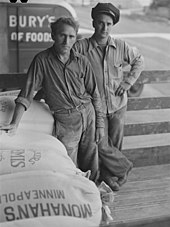Main article: History of Minneapolis
Sioux natives, city founded
Taoyateduta was among the 121 Sioux leaders who from 1837 to 1851 ceded the land where Minneapolis developed.[12]
In the early 19th century, the United States acquired this territory from France. It gradually established posts here. Fort Snelling was built in 1819 by the United States Army, and it attracted traders, settlers and merchants, spurring growth in the area. The United States government pressed the Mdewakanton band of the Dakota to sell their land, allowing people arriving from the East to settle here. The Minnesota Territorial Legislature authorized present-day Minneapolis as a town in 1856 on the Mississippi's west bank. Minneapolis incorporated as a city in 1867, the year rail service began between Minneapolis and Chicago. It later joined with the east-bank city of St. Anthony in 1872.[13]
Waterpower; lumber and flour milling
Minneapolis developed around Saint Anthony Falls, the highest waterfall on the Mississippi River and a source of power for its early industry. Forests in northern Minnesota were a valuable resource for the lumber industry, which operated seventeen sawmills on power from the waterfall. By 1871, the west river bank had twenty-three businesses, including flour mills, woolen mills, iron works, a railroad machine shop, and mills for cotton, paper, sashes, and planing wood.[14] Due to the occupational hazards of milling, six local sources of artificial limbs were competing in the prosthetics business by the 1890s.[15] The farmers of the Great Plains grew grain that was shipped by rail to the city's thirty-four flour mills. Millers have used hydropower elsewhere since the 1st century B.C.,[16] but the results in Minneapolis between 1880 and 1930 were so remarkable the city has been described as "the greatest direct-drive waterpower center the world has ever seen."[17]A father of modern milling in America and founder of what became General Mills, Cadwallader C. Washburn converted his business from gristmills to truly revolutionary technology, including "gradual reduction" processing by steel and porcelain roller mills capable of producing premium-quality pure white flour very quickly.[18][19] Some ideas were developed by William Dixon Gray[20] and some acquired through industrial espionage from the Hungarians by William de la Barre.[19] Charles A. Pillsbury and C.A. Pillsbury Company across the river were barely a step behind, hiring Washburn employees to immediately use the new methods.[19] The hard red spring wheat that grows in Minnesota became valuable ($.50 profit per barrel in 1871 increased to $4.50 in 1874,[18]) and Minnesota "patent" flour was recognized at the time as the best in the world.[19]
Not until later did consumers discover the value in the bran (which contains wheat's vitamins, minerals and fiber) that "Minneapolis... millers routinely dumped" into the Mississippi.[21] Millers cultivated relationships with academic scientists especially at the University of Minnesota. Those scientists backed them politically on many issues, for example during the early 20th century, when health advocates in the nascent field of nutrition criticized the flour "bleaching" process.[19] At peak production, a single mill at Washburn-Crosby made enough flour for 12 million loaves of bread each day,[22] and by 1900, 14.1 percent of America's grain was milled in Minneapolis.[18][19] Further, by 1895 through the efforts of silent partner William Hood Dunwoody, Washburn-Crosby exported four million barrels of flour a year to the United Kingdom,[23] and when exports reached their peak in 1900, about one third of all flour milled in Minneapolis was shipped overseas.[23]


No comments:
Post a Comment